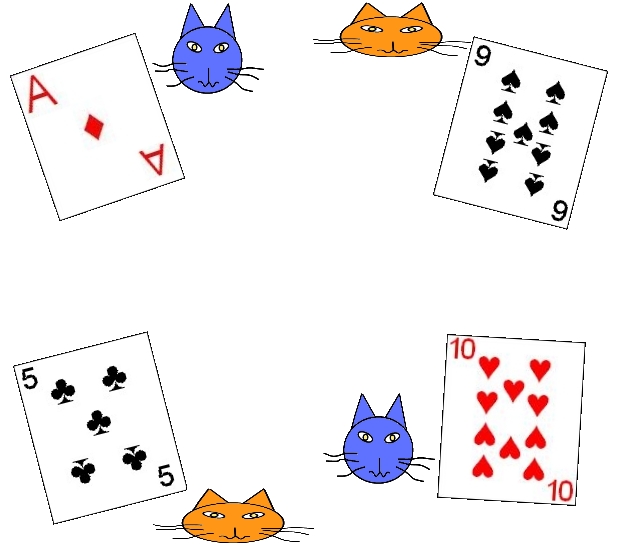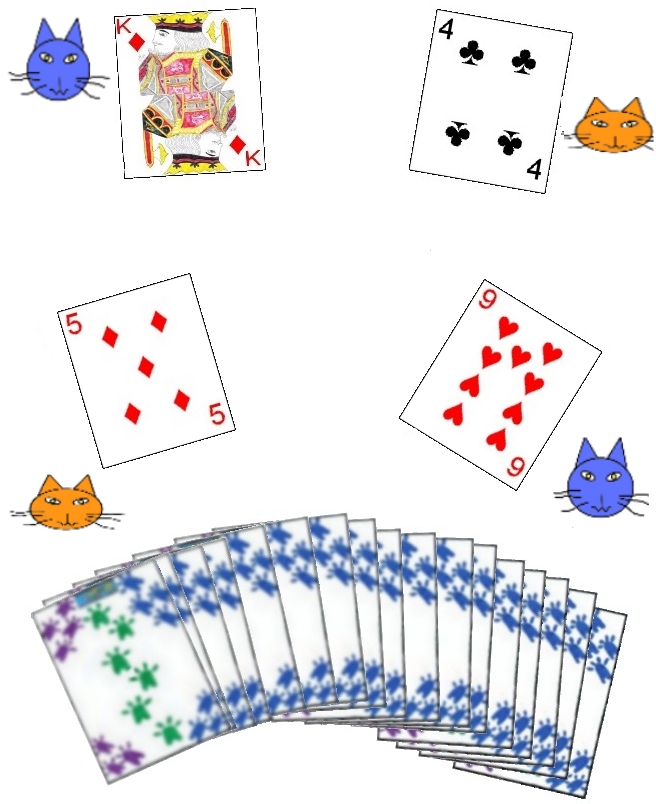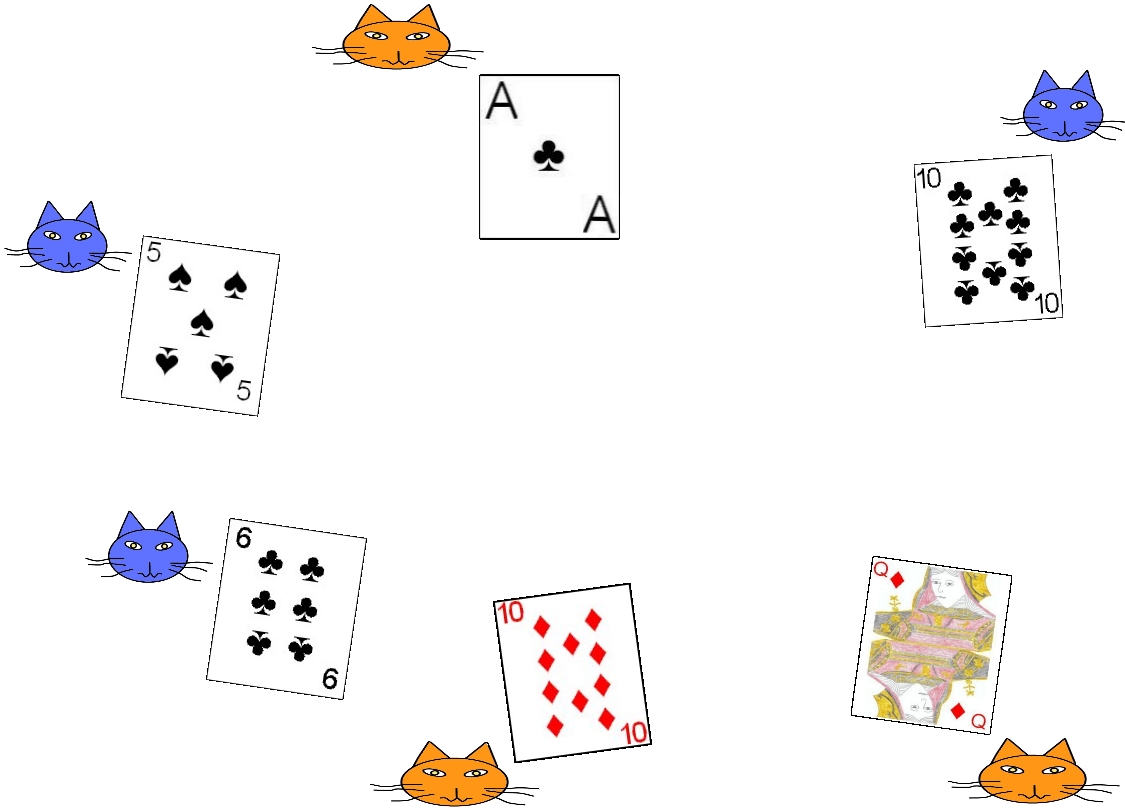Many card games involve partnerships, in which two or more players team together in an effort to defeat one or more other such partnerships. In some groups of card players these partnerships may be pre-arranged or cycled in a regular manner. However, in most instances, these partnerships are determined right before the players sit down to begin play.
Methods of Determining Partners for two partnerships:
In most instances the selection of the partnerships is a simple and straightforward process. There are several similar methods that are most often used when determining the partnerships for a hand or game. These methods are as follows:

Methods of Determining Partners for two partnerships:
In most instances the selection of the partnerships is a simple and straightforward process. There are several similar methods that are most often used when determining the partnerships for a hand or game. These methods are as follows:
- Cutting for Partnerships:
Any player can be temporarily chosen to thoroughly shuffle the cards. Each player then proceeds to cut the deck, displaying the bottom card from the top packet that is cut. The players cutting the two highest cards would then play as partners against the players who cut the two lowest such cards. For purposes of this draw, the ranking of the cards is as follows (from high to low): Ace, King, Queen, Jack, 10, 9, 8, 7, 6, 5, 4, 3, 2. If multiple players get equally ranked cards, the suits can be used to further order these similar cards. For this purpose, the suits are ranked, from highest to lowest: Spades (♠), Hearts (♥), Diamonds (♦), Clubs (♣). The partners would normally sit opposite each other at the table, such that players from each team alternate turns during the normal play of the hand. A separate draw would often occur to determine who is the first dealer, although in some cases the same cut could be used to determine the first dealer as well as partnerships.

- Drawing for Partnerships:
This method is very similar to the previous described method above, however instead of cutting for high card the players draw from a fanned out deck. As in the first method, any player is chosen to shuffle and cut the cards. He then places the deck, fanned out, face down in the center of the table. Each player would then proceed to randomly draw one card from the fanned out deck and expose it face up in front of himself. As in the previous method, the two players drawing the two highest cards would play against the two players who draw the two lowest. The numerical ranking of the cards is as follows (which is identical to the ranking in the first method), in descending order: Ace, King, Queen, Jack, 10, 9, 8, 7, 6, 5, 4, 3, 2. If two or more players draw equally ranked cards, these cards can be further ranked by suit, which are ranked, for purposes of this draw as follows (high to low): Spades, Hearts, Diamonds then Clubs. If just two players draw similar cards of any one particular rank, this further ranking is usually not necessary as the two players drawing the two similar ranked cards would be designated as partners against the two other players who would become the opposing partnership. In the illustration at right, for example, the players drawing the King and 9 (the two highest ranked cards) would play in partnership against the players drawing the two lowest ranked cards (the 4 and 5).

- Black and Red:
In this method, four cards are removed from the deck, any two red cards (Hearts (♥) or Diamonds (♦)) and any two black cards (Spades (♠) or Clubs (♣)). These four cards are then thoroughly mixed and placed face down on the table. Each player then takes one of these face down cards and exposes it face up on the table. The players drawing the two black cards become partners, playing against the opposing partnership consisting of the two players drawing each of the red cards. In the example illustration to the left, the players drawing the Red Ace and 10 would play in a partnership against the players pulling the black 5 and 9.
Determining partnerships consisting of three or more players:
The methods for determining the partnerships in games in which each partnership consists of more than two players is quite similar to those given above with a few differences. As in the first two methods above, each player would either draw or cut for a card from the deck and expose the card in front of himself. The players holding the specific number of highest cards corresponding to the number of players in each partnership would become partners against the same number of players who drew the three lowest ranked cards (i.e. for a game with two partnerships of three players each, the three highest ranked cards would play as a partnership against the players drawing the three lowest ranked cards). The specific numerical ranking and suit ranking (if needed) would be the same as for the cutting and drawing methods above. If the black and red method is used, simply add the appropriate number of additional cards of each color to the cards which the players would select from.
As in the first two methods above, each player would either draw or cut for a card from the deck and expose the card in front of himself. The players holding the specific number of highest cards corresponding to the number of players in each partnership would become partners against the same number of players who drew the three lowest ranked cards (i.e. for a game with two partnerships of three players each, the three highest ranked cards would play as a partnership against the players drawing the three lowest ranked cards). The specific numerical ranking and suit ranking (if needed) would be the same as for the cutting and drawing methods above. If the black and red method is used, simply add the appropriate number of additional cards of each color to the cards which the players would select from.
As an example, consider the illustration to the right in which two partnerships are to be drawn for, each partnership consisting of three players. The first partnership would consist of the players drawing the 5, 6 and 10 (of clubs) which are the three lowest ranked cards drawn, while their opposing partnership would be the three players who drew the Ace, Queen and 10 (of diamonds) which are the three highest cards in the draw.
As with games for partnerships containing two players per partnership, the final seating arrangement should be such that players from each partnership alternate around the table. Thus, during the play of the hand, the turn as it rotates around the table would alternate between players from each partnership.
Note that oftentimes in games in which there are varying numbers of players in a partnership, the game itself has specific rules for determining the partnerships (such as the holder of a specific card during the play of the hand) and these partnerships may change from hand to hand. This will usually be detailed in a games specific description, as this is very much a part of the nuances of that particular game.
Determining partners for more than two partnerships:
In some games there may be three or more partnerships involved in the play of the hand or game. The method to do this is also similar to the first two methods above (if using the red black method, this can be extended to adding a specific number of cards of specific suits instead of by individual color), however it would extend to the appropriate and necessary number of partnerships. Thus each player would either draw or be dealt a card from the shuffled deck. The two players drawing the two highest ranked cards would become the first partnership. The players drawing the next two highest ranking cards would be the next partnership, and so on down to the two players drawing the two lowest ranked cards becoming the final partnership.
Partnership Changes:
Once determined the specific partnerships would generally remain the same for the entirety of the game. At the completion of the game, if another such game is to be played, these same rules for determining initial partnerships would generally be followed to re-select partnerships for the new game. Alternatively, and often in tournament settings, the partnerships would be required to change in some predetermined manner, so that each player would have a different partner than in the previous game or hand. There are a number of methods used for this partner rotation including, clockwise player rotation, counterclockwise rotation and other similar methods. The basic idea is for each player to have a different partner than in the previous hand and, if possible, play with a different partner each time, with, in the ideal setting each player playing as a partner with and as an opponent against every other active player. This allows for the greatest degree of fairness and variety in the play of the games.
Supplemental Information:
Many games provide specific rules for determination of partnerships in a game. In the case where the game does include specific rules for determination of partnerships, those instructions should have precedence and be adopted rather than any general instructions given here.
The methods for determining the partnerships in games in which each partnership consists of more than two players is quite similar to those given above with a few differences.
 As in the first two methods above, each player would either draw or cut for a card from the deck and expose the card in front of himself. The players holding the specific number of highest cards corresponding to the number of players in each partnership would become partners against the same number of players who drew the three lowest ranked cards (i.e. for a game with two partnerships of three players each, the three highest ranked cards would play as a partnership against the players drawing the three lowest ranked cards). The specific numerical ranking and suit ranking (if needed) would be the same as for the cutting and drawing methods above. If the black and red method is used, simply add the appropriate number of additional cards of each color to the cards which the players would select from.
As in the first two methods above, each player would either draw or cut for a card from the deck and expose the card in front of himself. The players holding the specific number of highest cards corresponding to the number of players in each partnership would become partners against the same number of players who drew the three lowest ranked cards (i.e. for a game with two partnerships of three players each, the three highest ranked cards would play as a partnership against the players drawing the three lowest ranked cards). The specific numerical ranking and suit ranking (if needed) would be the same as for the cutting and drawing methods above. If the black and red method is used, simply add the appropriate number of additional cards of each color to the cards which the players would select from.
As an example, consider the illustration to the right in which two partnerships are to be drawn for, each partnership consisting of three players. The first partnership would consist of the players drawing the 5, 6 and 10 (of clubs) which are the three lowest ranked cards drawn, while their opposing partnership would be the three players who drew the Ace, Queen and 10 (of diamonds) which are the three highest cards in the draw.
As with games for partnerships containing two players per partnership, the final seating arrangement should be such that players from each partnership alternate around the table. Thus, during the play of the hand, the turn as it rotates around the table would alternate between players from each partnership.
Note that oftentimes in games in which there are varying numbers of players in a partnership, the game itself has specific rules for determining the partnerships (such as the holder of a specific card during the play of the hand) and these partnerships may change from hand to hand. This will usually be detailed in a games specific description, as this is very much a part of the nuances of that particular game.
Determining partners for more than two partnerships:
In some games there may be three or more partnerships involved in the play of the hand or game. The method to do this is also similar to the first two methods above (if using the red black method, this can be extended to adding a specific number of cards of specific suits instead of by individual color), however it would extend to the appropriate and necessary number of partnerships. Thus each player would either draw or be dealt a card from the shuffled deck. The two players drawing the two highest ranked cards would become the first partnership. The players drawing the next two highest ranking cards would be the next partnership, and so on down to the two players drawing the two lowest ranked cards becoming the final partnership.
Partnership Changes:
Once determined the specific partnerships would generally remain the same for the entirety of the game. At the completion of the game, if another such game is to be played, these same rules for determining initial partnerships would generally be followed to re-select partnerships for the new game. Alternatively, and often in tournament settings, the partnerships would be required to change in some predetermined manner, so that each player would have a different partner than in the previous game or hand. There are a number of methods used for this partner rotation including, clockwise player rotation, counterclockwise rotation and other similar methods. The basic idea is for each player to have a different partner than in the previous hand and, if possible, play with a different partner each time, with, in the ideal setting each player playing as a partner with and as an opponent against every other active player. This allows for the greatest degree of fairness and variety in the play of the games.
Supplemental Information:
Many games provide specific rules for determination of partnerships in a game. In the case where the game does include specific rules for determination of partnerships, those instructions should have precedence and be adopted rather than any general instructions given here.